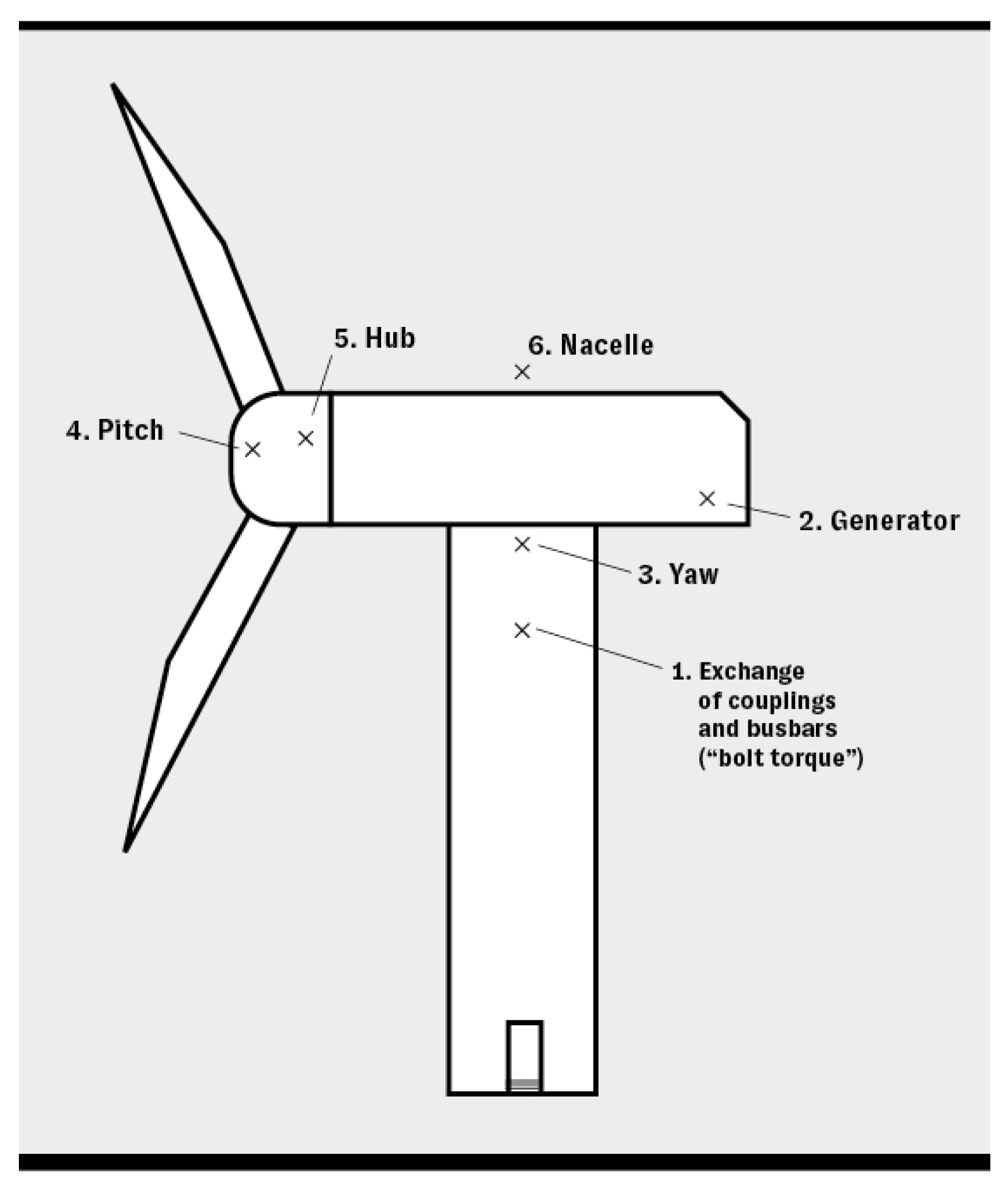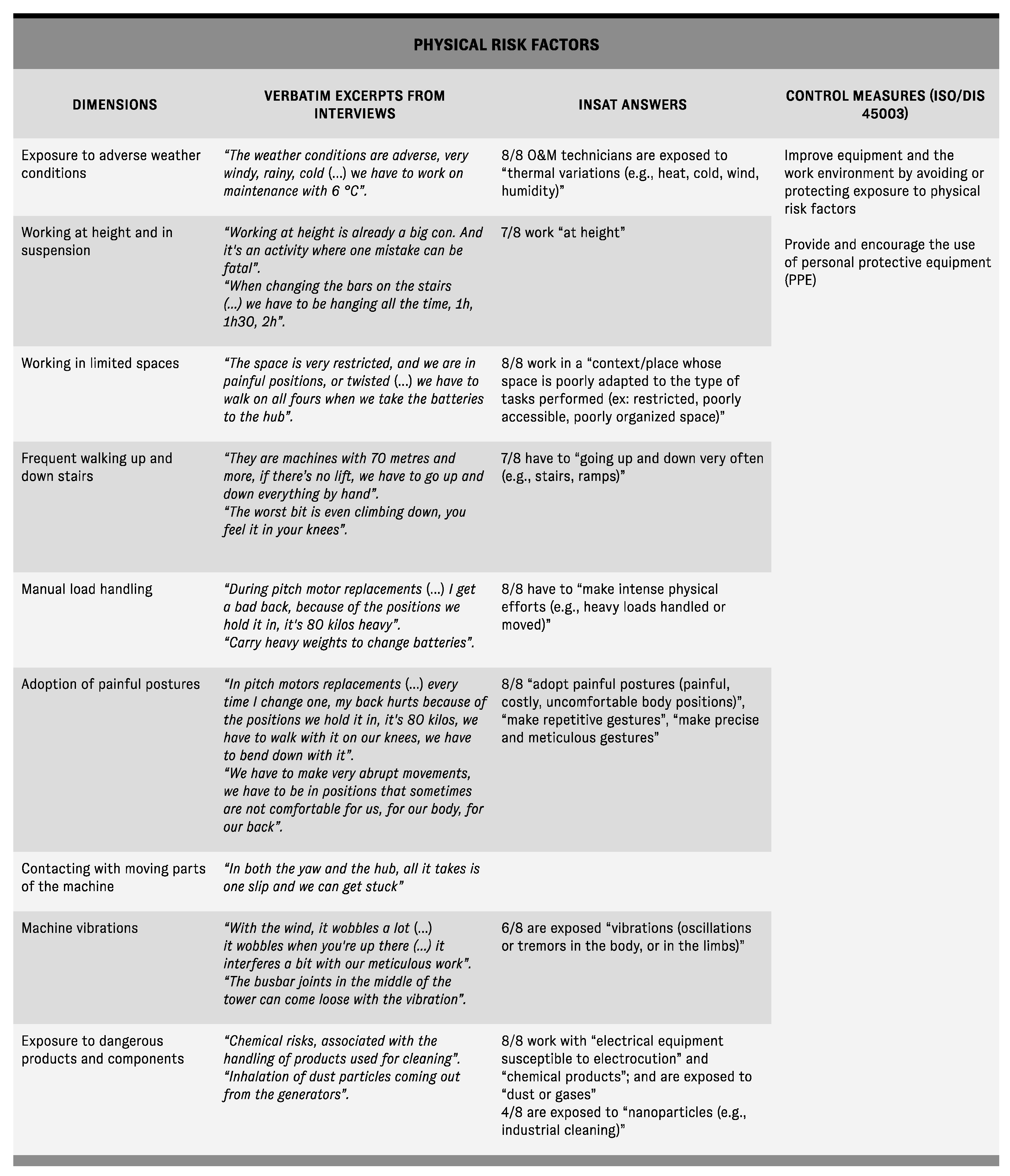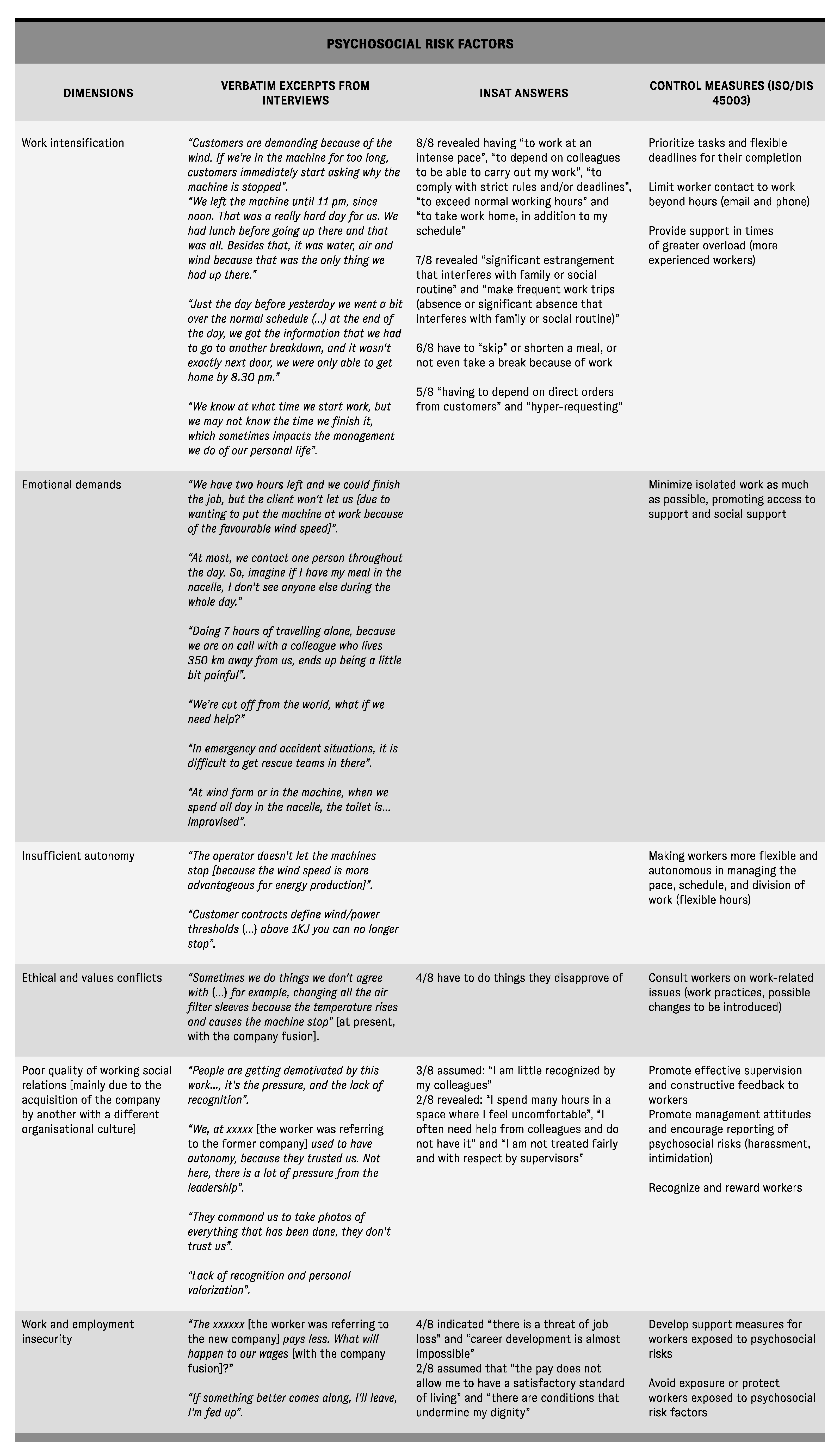Different Shades of Green: An Analysis of the Occupational Health and Safety Risks Faced by Wind Farm Workers
Abstract
1. Introduction
1.1. Green and Sustainable Purposes for the Environment, but What about the Workers?
1.2. Research Questions and Objectives
2. Materials and Methods
- -
- “Background to my working day” (including the wind farm where the work was being performed; weather conditions; characterization of the wind turbines; type of intervention to be done; tasks performed; co-workers; and the conditions that affected the work plan).
- -
- Work schedule (including the expected and actual schedule, time travelling to and from the wind farm; time spent inside the machine (wind turbine); and the work pace determined by the need to attain the goals).
- -
- “My day in review” (including “what gave me the most pleasure at work”; “what went worst”; unforeseen or critical situations; what required more expertise; and what made the work easier).
- -
- “My health and wellbeing” (including the identification of pain and affected body areas, relating them to tasks that were performed; situations of incidents/accidents; health issues that were aggravated by the work).
- -
- “My working week in review (including the most painful day in the working week; “what went best” and why).
3. Results and Discussion
3.1. Activity Content: Interventions on Onshore Wind Turbines
3.2. A Not-So-Green Shade: The Exposure to Physical and Psychosocial Risk Factors
3.3. The Perceived Impacts of Work on Health
3.4. Study Limitations
4. Conclusions: A “Rapid Wear Profession” vs. a ‘Green Job’
Author Contributions
Funding
Institutional Review Board Statement
Informed Consent Statement
Data Availability Statement
Conflicts of Interest
References
- UNCTAD—United Nations Conference on Trade and Development. Structural Transformation, Industry 4.0 and Inequality: Science, Technology and Innovation Policy Challenges; UNCTAD: Geneve, Switzerland, 2019. [Google Scholar]
- Daniellou, F. The French-speaking ergonomists’ approach to work activity: Cross-influences of field intervention and conceptual models. Theor. Issues Ergon. Sci. 2005, 6, 409–427. [Google Scholar] [CrossRef]
- Lacomblez, M.; Bellemare, M.; Chatigny, C.; Delgoulet, C.; Re, A.; Trudel, L.; Vasconcelos, R. Ergonomic analysis of work activity and training: Basic paradigm, evolutions and challenges. In Meeting Diversity in Ergonomics; Pikaar, R., Koningsveld, E., Settels, P., Eds.; Elsevier: Oxford, UK, 2007; pp. 129–142. [Google Scholar] [CrossRef]
- EU-OSHA—European Agency for Safety and Health at Work. Occupational Safety and Health in the Wind Energy Sector; EU-OSHA: Bilbao, Spain, 2013. [CrossRef]
- Regulation (EU) 2021/1119 of the European Parliament and of the Council of 30 June 2021. Available online: https://ec.europa.eu/clima/policies/eu-climate-action/law_pt (accessed on 30 July 2021).
- Portugal Energia. Plano Nacional Energia e Clima 2021–2030. In Resolução do Conselho de Ministros n.º 53/2020, de 10 de Julho; Presidência do Conselho de Ministros: Lisboa, Portugal, 2020. [Google Scholar]
- APREN—Associação Portuguesa de Energias Renováveis. Novo Máximo Histórico de Energia Eólica na União Europeia. 2017. Available online: https://www.apren.pt/pt/novo-maximo-historico-de-energia-eolica-na-uniao-europeia (accessed on 7 May 2021).
- APREN—Associação Portuguesa de Energias Renováveis. Anuário APREN. 2023. Available online: https://www.apren.pt/contents/documents/a-card-280723-02-final.pdf (accessed on 26 December 2023).
- APREN—Associação Portuguesa de Energias Renováveis and Deloitte. Impacto da Eletricidade de Origem Renovável. 2019. Available online: https://www.apren.pt/pt/deloitte-lanca-estudo-sobre-o-impacto-da-eletricidade-de-origem-renovavel-em-portugal (accessed on 20 May 2021).
- International Renewable Energy Agency (IREA) and International Labour Organization (ILO). Renewable Energy and Jobs: Annual Review 2023; IRENA: Abu Dhabi, United Arab Emirates, 2023. Available online: https://www.irena.org/Publications/2023/Sep/Renewable-energy-and-jobs-Annual-review-2023 (accessed on 3 March 2024).
- European Commission. Exploiting the Employment Potential of Green Growth. Communication from the Commission to the European Parliament, the Council, the European Economic and Social Committee and the Committee of the Regions, Towards a Job-Rich Recovery. Strasbourg, 2012. Available online: https://eur-lex.europa.eu/LexUriServ/LexUriServ.do?uri=SWD:2012:0092:FIN:EN:PDF (accessed on 24 April 2022).
- ILO—International Labour Office. Green Jobs. Progress Report 2014-2015; ILO: Geneva, Switzerland, 2016. Available online: https://www.ilo.org/wcmsp5/groups/public/---ed_emp/---emp_ent/documents/publication/wcms_502730.pdf (accessed on 20 January 2018).
- UNEP—United Nations Environment Programme. Green Jobs: Towards Decent Work in a Sustainable, Low-Carbon World; UNEP/ILO/IOE/ITUC: Nairobi, Kenya, 2008. Available online: https://www.unep.org/resources/report/green-jobs-towards-sustainable-work-low-carbon-world (accessed on 4 March 2024).
- Lynch, M. Workers and the Climate Challenge. Hesamag 2023, 38, 31–33. Available online: https://www.etui.org/publications/workers-and-climate-challenge (accessed on 3 March 2024).
- Freiberg, A.; Schefter, C.; Girbig, M.; Murta, C.; Seidler, A. Health effects of wind turbines in working environments—A scoping review. Scand. J. Work. Environ. Health 2018, 44, 351–369. [Google Scholar] [CrossRef] [PubMed]
- Jia, N.; Li, T.; Hu, S.; Zhu, X.; Sun, K.; Yi, L.; Zhang, Q.; Luo, G.; Li, Y.; Zhang, X.; et al. Prevalence and its risk factors for low back pain among operation and maintenance personnel in wind farms. BMC Musculoskelet. Disord. 2016, 17, 314. [Google Scholar] [CrossRef]
- Wandzich, D.; Plaza, G. New and emerging risks associated with green workplaces. Workplace Health Saf. 2017, 65, 493–500. [Google Scholar] [CrossRef] [PubMed]
- Karanikas, N.; Steele, S.; Bruschi, K.; Robertson, C.; Kass, J.; Popovich, A.; MacFadyen, C. Occupational health hazards and risks in the wind industry. Energy Rep. 2021, 7, 3750–3759. [Google Scholar] [CrossRef]
- EU-OSHA—European Agency for Safety and Health at Work. Questões de Segurança e Saúde no Trabalho Associados à Construção Ecológica. 2014. Available online: https://osha.europa.eu/pt/publications/e-fact-79-occupational-safety-and-health-wind-energy-sector (accessed on 10 March 2024).
- Mette, J.; Velasco Garrido, M.; Harth, V.; Preisser, A.; Mache, S. Healthy offshore workforce? A qualitative study on offshore wind employees’ occupational strain, health, and coping. BMC Public Health 2018, 18, 172. [Google Scholar] [CrossRef] [PubMed]
- Sgourou, E.; Katsakioril, P.; Kavvathas, A. Occupational health and safety in wind turbines’ maintenance: An investigation of maintenance technicians’ perceptions. Ecol. Saf. 2021, 15, 43–55. [Google Scholar]
- Fischer, S.; Koltun, S.; Lee, J. A cross-sectional survey of musculoskeletal disorder hazard exposures and self-reported discomfort among onshore wind turbine service technicians. Ergonomics 2021, 64, 383–395. [Google Scholar] [CrossRef]
- Cooper, K.; Stewart, A.; Kirkpatrick, P. Health effects associated with working in the wind power generation industry: A comprehensive systematic review. JBI Database Syst. Rev. Implement. Rep. 2014, 12, 327–373. [Google Scholar] [CrossRef]
- Gollac, M.; Bodier, M. Mesurer les Facteurs Psychosociaux de Risque au Travail Pour les Maîtriser. Rapport du Collège D’expertise sur le Suivi des Risques Psychosociaux au Travail, Faisant Suite à la Demande. Ministre du travail, de l’emploi et de la santé: Paris, 2011. Available online: http://travail-emploi.gouv.fr/IMG/pdf/rapport_SRPST_definitif_rectifie_11_05_10.pdf (accessed on 12 June 2016).
- Cunha, L.; Barros, C. The evaluation of psychosocial risks: An emerging issue? And its prevention… a postponed issue? J. Spat. Organ. Dyn. 2018, 6, 19–28. [Google Scholar]
- Barros, C.; Baylina, P.; Cunha, L. Impact of Psychosocial Risk Factors on Workers’ Health: Contributions of a Subjective Health Indicator. In Occupational and Environmental Safety and Health II; Arezes, P.M., Baptista, J.S., Barroso, M.P., Carneiro, P., Cordeiro, P., Costa, N., Melo, R.B., Miguel, A.S., Perestrelo, G., Eds.; Springer: Berlin/Heidelberg, Germany, 2020; Volume 277, pp. 557–566. [Google Scholar] [CrossRef]
- Clot, Y. Travail et Pouvoir d’agir; Presses Universitaires de France: Paris, France, 2008. [Google Scholar]
- Clot, Y.; Simonet, P. Power to act and operational leeway. Le Trav. Hum. 2015, 78, 31–52. [Google Scholar] [CrossRef]
- Van Belleghem, L.; De Gasparo, S.; Gaillard, I. The development of the psychosocial dimension of work. In Constructive Ergonomics; Falzon, P., Ed.; CRC Press: New York, NY, USA, 2014; pp. 33–47. [Google Scholar] [CrossRef]
- Aneziris, O.; Papazoglou, I.; Psinias, A. Occupational risk for an onshore wind farm. Saf. Sci. 2016, 88, 188–198. [Google Scholar] [CrossRef]
- Bepary, B.; Kabir, G. Occupational risk assessment of wind turbines in Bangladesh. Appl. Syst. Innov. 2022, 5, 34. [Google Scholar] [CrossRef]
- Guérin, F.; Laville, A.; Daniellou, F.; Duraffourg, J.; Kerguelen, A. Understanding and Transforming Work: The Practice of Ergonomics; Anact: Lyon, France, 2007. [Google Scholar]
- St-Vincent, M.; Vézina, N.; Bellemare, M.; Denis, D.; Ledoux, E.; Imbeau, D. Ergonomic Intervention; IRSST: Montréal, QC, Canada, 2014. [Google Scholar]
- Clot, Y. Le Travail à Cœur: Pour en Finir Avec Les Risques Psychosociaux; La Découverte: Paris, France, 2010. [Google Scholar]
- Lhuilier, D. La santé mentale au travail. In Un Monde Commun: Les Savoirs des Sciences Humaines et Sociales; Gefen, A., Ed.; CNRS Éditions: Paris, France, 2023; pp. 262–265. [Google Scholar]
- Lhuilier, D.; Litim, M. Le rapport santé-travail en psychologie du travail. Mouvements 2009, 2, 85–96. [Google Scholar] [CrossRef]
- Burawoy, M. Ethnography Unbound. Power and Resistance in Modern Metropolis; University of California Press: Berkeley, CA, USA, 1991. [Google Scholar]
- Barros, C.; Cunha, L.; Baylina, P.; Oliveira, A.; Rocha, Á. Development and Validation of a Health and Work Survey Based on the Rasch Model among Portuguese Workers. J. Med. Syst. 2017, 41, 79. [Google Scholar] [CrossRef] [PubMed]
- Gunthert, K.; Wenze, S. Daily diary methods. In Handbook of Research Methods for Studying Daily Life; Mehl, M.R., Conner, T.S., Eds.; Guildford: New York, NY, USA, 2012; pp. 144–159. [Google Scholar]
- Andéol, M. Le «cadastre du risque avéré». Rives Méditerranéennes 2020, 61, 179–204. [Google Scholar] [CrossRef]
- Vermersch, P. Expliciter l’expérience. Éducation Perm. 1989, 100, 123–131. [Google Scholar]
- Milligan, G.; O’Halloran, J.; Tipton, M. A job task analysis for technicians in the offshore wind industry. Work: A J. Prev. Assess. Rehabil. 2019, 63, 537–545. [Google Scholar] [CrossRef]
- ISO/DIS 45003; Occupational Health and Safety Management—Psychological Health and Safety at Work: Managing Psychosocial Risks—Guidelines. ISO—International Organization for Standardization: Geneva, Switzerland, 2020.
- Chaumel, J.-L.; Giraud, L.; Ilinca, A. Secteur éolien—Risques en Santé et en Sécurité au Travail et Stratégies de Prévention; Institut de Recherche Robert-Sauvé en Santé et en Sécurité du Travail: Montréal, QC, Canada, 2014.
- Leplat, J. De l’étude de cas à l’analyse de l’activité. Perspect. Interdiscip. Trav. Santé 2002, 4, 3658. [Google Scholar] [CrossRef]
- Barros-Duarte, C.; Carnide, F.; Cunha, L.; Santos, M.; Silva, C. Will I be able to do my work at 60? An analysis of working conditions that hinder active ageing. Work: A J. Prev. Assess. Rehabil. 2015, 51, 579–590. [Google Scholar] [CrossRef]
- Moreira, S.; Vasconcelos, L.; Silva Santos, C. Occupational health indicators: Exploring the social and decent work dimensions of green jobs in Portugal. Work: A J. Prev. Assess. Rehabil. 2018, 61, 189–209. [Google Scholar] [CrossRef]
- Taylor, J.; Klenk, N. The politics of evidence: Conflicting social commitments and environmental priorities in the debate over wind energy and public health. Energy Res. Soc. Sci. 2019, 47, 102–112. [Google Scholar] [CrossRef]
- European Commission. Report on a Toolkit for National and Regional Decision-Makers. Supporting Sustainability Transitions under the European Green Deal with Cohesion Policy; Publications Office of the European Union: Luxembourg, 2021. [Google Scholar]




| Methods and Instruments | n | Objective | |
|---|---|---|---|
| Stage 1 | Document analysis | --- | Review of the company’s internal documents on occupational risks and health safety:
|
| Interviews with the company’s key interlocutors (HR; OHS Service; Ergonomics; Quality Management) | n = 5 | Map the company’s main historical milestones, which impacted the forms of work organization, the constitution of work teams, and the evolution of risks to which workers are exposed. | |
| Stage 2 | Observations at wind farms (12 h) | n = 10 | Free observations of the work activity of five pairs of O&M technicians at four wind farms (including the work performed inside the wind turbines and in the corresponding control rooms) |
| Activity diary | n = 6 | Collect self-reported data (once a day for one working week) on the relation between the work done each day, its conditions and organization, and perceived health. | |
| Collective interviews with pairs of O&M technicians | n = 17 | Seven interviews with pairs of O&M technicians (7 × 2) and one interview with three technicians. These moments were dedicated to exploring (i) the experience of working in the wind sector; (ii) the ways of developing and preserving a collective experience within each pair of technicians; (iii) the variability of operating modes; (iv) the difficulties and risks of the work and their perceived impact on health; and (v) the main strategies for preserving oneself and the pair. | |
| INSAT Survey | n = 8 | Extend the analysis regarding the relationship between the perceived work risk factors and the health impacts. | |
| Stage 3 | Collective restitution and validation sessions (two sessions, lasting on average 1 h) | n = 13 | Final sessions to present the results of the analysis and its validation with the O&M technicians, focusing on the most demanding tasks, physical and psychosocial risk factors identified, health impacts, and conditions pointed out by the workers as favouring the preservation of their health. Prior to these sessions, an infographic synthesizing these results was prepared and sent to all the workers and team coordinators. |
Disclaimer/Publisher’s Note: The statements, opinions and data contained in all publications are solely those of the individual author(s) and contributor(s) and not of MDPI and/or the editor(s). MDPI and/or the editor(s) disclaim responsibility for any injury to people or property resulting from any ideas, methods, instructions or products referred to in the content. |
© 2024 by the authors. Licensee MDPI, Basel, Switzerland. This article is an open access article distributed under the terms and conditions of the Creative Commons Attribution (CC BY) license (https://creativecommons.org/licenses/by/4.0/).
Share and Cite
Cunha, L.; Silva, D.; Macedo, M. Different Shades of Green: An Analysis of the Occupational Health and Safety Risks Faced by Wind Farm Workers. Sustainability 2024, 16, 3012. https://doi.org/10.3390/su16073012
Cunha L, Silva D, Macedo M. Different Shades of Green: An Analysis of the Occupational Health and Safety Risks Faced by Wind Farm Workers. Sustainability. 2024; 16(7):3012. https://doi.org/10.3390/su16073012
Chicago/Turabian StyleCunha, Liliana, Daniel Silva, and Mariana Macedo. 2024. "Different Shades of Green: An Analysis of the Occupational Health and Safety Risks Faced by Wind Farm Workers" Sustainability 16, no. 7: 3012. https://doi.org/10.3390/su16073012
APA StyleCunha, L., Silva, D., & Macedo, M. (2024). Different Shades of Green: An Analysis of the Occupational Health and Safety Risks Faced by Wind Farm Workers. Sustainability, 16(7), 3012. https://doi.org/10.3390/su16073012







